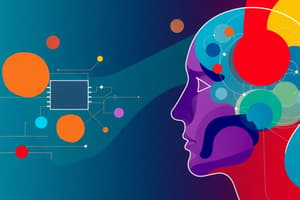Podcast
Questions and Answers
What did Weller (2004) find about locating items for information?
What did Weller (2004) find about locating items for information?
- Grouping information with borders took less time than using color contrast. (correct)
- Using color contrast was more effective than borders.
- Fonts have a greater effect than borders in finding information.
- Too much white space improves locating information.
Sensory memory can last up to 10-15 seconds.
Sensory memory can last up to 10-15 seconds.
False (B)
What is the main reason why interfaces are largely visual?
What is the main reason why interfaces are largely visual?
We recognize things much better than being able to recall them.
Miller's Magic Number for short-term memory capacity is _____ ± 2.
Miller's Magic Number for short-term memory capacity is _____ ± 2.
Match the type of memory with its duration:
Match the type of memory with its duration:
Which of the following cognitive aspects is most relevant to interaction design?
Which of the following cognitive aspects is most relevant to interaction design?
Cluttering the interface enhances user attention and perception.
Cluttering the interface enhances user attention and perception.
What is the main cause identified for the difference in search times between the two screens in Tullis's study?
What is the main cause identified for the difference in search times between the two screens in Tullis's study?
The cognitive process involved in focusing on relevant information from numerous stimuli is called ______.
The cognitive process involved in focusing on relevant information from numerous stimuli is called ______.
Match the following design techniques with their intended effects:
Match the following design techniques with their intended effects:
What does the study of Human Factors primarily focus on?
What does the study of Human Factors primarily focus on?
What is the primary focus of Human Factors psychology in relation to technology?
What is the primary focus of Human Factors psychology in relation to technology?
Human Factors encompasses both behavioral and non-behavioral variables in its study.
Human Factors encompasses both behavioral and non-behavioral variables in its study.
Cognitive load refers to the amount of information the brain can handle at one time.
Cognitive load refers to the amount of information the brain can handle at one time.
What is meant by 'cognition' in the context of Human-Computer Interaction?
What is meant by 'cognition' in the context of Human-Computer Interaction?
What are two cognitive issues that must be considered in Human Factors?
What are two cognitive issues that must be considered in Human Factors?
The study of how humans accomplish work-related tasks in the context of __________ is known as Human Factors.
The study of how humans accomplish work-related tasks in the context of __________ is known as Human Factors.
Match the following cognitive concepts with their definitions:
Match the following cognitive concepts with their definitions:
___ applies principles of Cognitive Psychology to enhance user interaction with technology.
___ applies principles of Cognitive Psychology to enhance user interaction with technology.
Match the cognitive issues to their descriptions:
Match the cognitive issues to their descriptions:
Flashcards
Human Factors
Human Factors
The study of how humans perform work-related tasks in the context of human-machine systems.
Behavioral Variables
Behavioral Variables
A set of psychological constraints that determine how humans process information.
Non-behavioral Variables
Non-behavioral Variables
A set of physical limitations that affect our ability to use a system.
Human Factors Design
Human Factors Design
Signup and view all the flashcards
Human Performance Models
Human Performance Models
Signup and view all the flashcards
Memory in Human Factors
Memory in Human Factors
Signup and view all the flashcards
Cognitive Load
Cognitive Load
Signup and view all the flashcards
Why Human Factors is Important in Computer Science
Why Human Factors is Important in Computer Science
Signup and view all the flashcards
Visual Perception in Software Design
Visual Perception in Software Design
Signup and view all the flashcards
Perceptibility
Perceptibility
Signup and view all the flashcards
Visual Grouping
Visual Grouping
Signup and view all the flashcards
Sensory Memory
Sensory Memory
Signup and view all the flashcards
Retrieval
Retrieval
Signup and view all the flashcards
Semantic Memory
Semantic Memory
Signup and view all the flashcards
Attention
Attention
Signup and view all the flashcards
Perception
Perception
Signup and view all the flashcards
Recognition
Recognition
Signup and view all the flashcards
Memory
Memory
Signup and view all the flashcards
Designing for Attention
Designing for Attention
Signup and view all the flashcards
Study Notes
Human Computer Interaction: Cognition and Mental Models
- Human-computer interaction (HCI) encompasses the human aspects of designing computer applications and hardware, focusing on effective interaction between humans and computers.
- HCI considers human capabilities and limitations to create intuitive and accessible designs.
- Understanding how people process information (cognition) plays a vital role in designing effective interfaces.
- Everyday frustrations with software highlight the importance of understanding user needs.
- Studying how people think and behave helps designers craft more user-friendly systems.
- Human factors study examines human behavior in the context of technology; it differs from experimental psychology, which studies human behavior in general, by focusing on how humans interact with technology.
- Human factors (ergonomics) combines insights from engineering, psychology, and physiology & medicine.
- HCI incorporates user considerations in tools, which means considering user perception, cognitive limitations, and ways of interacting with various technological systems (e.g. computer applications & hardware).
- Color, organization, and spacing are critical for user attention and perception in interface design.
- Perceptible aspects of an interface (e.g. legible text, icons) are crucial to good design.
- Memory, both short-term and long-term, significantly impacts how efficiently people use a technology.
- Encoding, or interpreting information, is the first stage of memory processing. The more attention paid to something, and the more it's processed intellectually, means the more likely it is to be remembered.
- Immediate memory capacity is limited (Miller's Magic Number 7 ± 2).
- Design should facilitate recognition instead of having to recall details.
- Mental models of a system are developed through learning and use—these include knowledge of how to use a system, process information, and handle unfamiliar situations.
- Users apply mental models to every day situations, such as operating a thermostat to heat a house or using an ATM to withdraw money.
- Users can sometimes hold erroneous mental models that impact their experience with a product (e.g. thinking a thermostat is like a valve).
- Norman's (1986) seven-stage model of action describes a structured way of implementing an activity.
- Cognitive user modeling attempts to predict how a user will interact with an interface based on their cognitive characteristics and knowledge.
- Modeling aspects of a user's cognition, knowledge, intentions, and processing is crucial for predicting user interaction.
- Models can range in specificity, from high-level plans and problems to basic user actions like keystrokes.
- Different modeling approaches exist, including models based on human info processing.
- Externalizing potentially complex functions or memory requirements to the environment can reduce a user's memory load (e.g. external calendars, notes, etc).
Studying That Suits You
Use AI to generate personalized quizzes and flashcards to suit your learning preferences.




